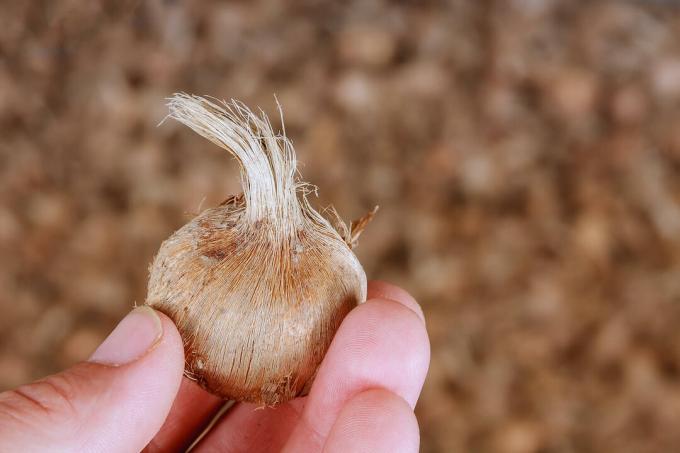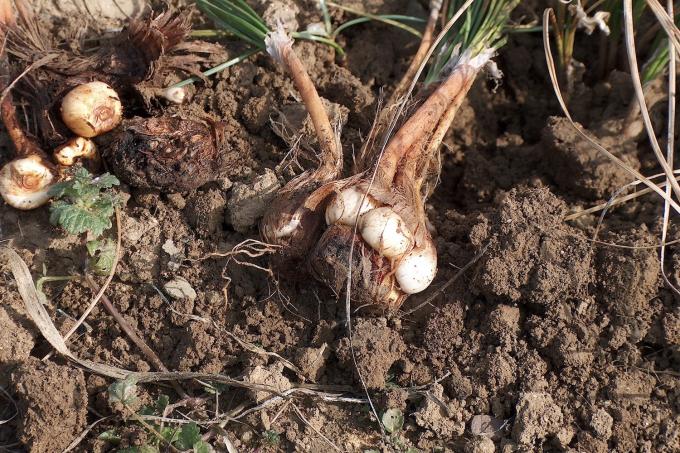It is the most expensive spice in the world - saffron. We will show you whether and how you can grow this extraordinary spice in your own garden.

with saffron (Crocus sativus) dishes are not only seasoned, but refined. A single gram of the valuable spice costs 10 to 20 euros, depending on the quality. The autumn crocus also thrives in our latitudes, even if it cannot be harvested often. We give tips on planting, care and use of the saffron crocus.
contents
- Saffron crocus: origin and properties
-
grow saffron
- The right location for saffron
- plant saffron
- Caring for saffron crocus
- multiply saffron
- Overwintering saffron crocus
- Saffron as a spice: uses and ingredients
Saffron crocus: origin and properties
The perennial saffron crocus from the iris family (Iridaceae) originated in the Aegean. It is mainly grown in warm Mediterranean regions and the Middle East. Saffron is only accidentally mutated from the related species of crocus
Crocus cartwrightianus developed. On the one hand, larger flowers developed, on the other hand, significantly longer and larger style threads on which the stigmas sit. It is precisely these characteristic, long, deep red saffron threads that are relevant for saffron cultivation. They contain the slightly bitter, spicy saffron aroma and the strong coloring power. These saffron strands form during the flowering of the purple autumn crocus in October to November. However, the sensitive handles do not tolerate temperatures below 15 °C, and so the saffron spice can actually only be harvested in very mild wine-growing regions. In all other areas, however, it is worth planting saffron simply because of its ornamental value low maintenance and the late flowering period, which reminds us of the past crocus bloom in spring.
grow saffron
The cultivation of the precious saffron plant is not easy, because it places high demands on its location. In individual cases, however, the cultivation of the expensive spice can also succeed in sheltered and warm locations in our home gardens. However, in order to be able to harvest any significant amount, about 150 flowers would have to be grown for 1 g of dried saffron threads.
The right location for saffron
Saffron plants prefer dry, sunny locations on loose, sandy and calcareous soil. Waterlogging must be avoided at all costs, otherwise the tubers and roots will quickly rot in the soil. Whether in a pot or bed, the saffron crocus prefers to be sheltered from the wind and warm. This increases the chance of being able to harvest the stalks in autumn. For this, the autumn crocus needs constant temperatures of around 15 °C during flowering, even in September and October.
plant saffron
Saffron is only propagated vegetatively, so small saffron bulbs are planted directly in the ground. The small tubers can be planted directly in the ground or in a pot from July to the end of August. For the cultivation of saffron in a pot, the planter should be big enough, which makes fertilization easier later. The pot should hold at least 10 liters for a single tuber, which also multiplies underground in late autumn and forms daughter tubers. A nutrient-rich potting soil is particularly recommended for pot culture. Instead of climate-damaging peat, we recommend soil with a high compost content, which stores moisture and provides nutrients over the long term. The potting soil should be enriched with at least 30% sand, perlite, broken lava or coarse broken bricks. At the bottom of the pot, a drainage layer of at least ¼ the height of the pot should be filled. Broken bricks, expanded clay or pebbles are suitable for this.

The saffron tubers are placed at a depth of 15 cm, with the tubers about 15 cm apart. To protect the tubers from voles, a vole basket can be used when planting.
Caring for saffron crocus
After planting, the saffron initially does not need watering, because the tubers contain enough water for root formation and budding. In the further cultivation, occasional watering in extreme heat and dryness in late summer September is completely sufficient to supply the tuber with the exhausting flower formation. During the dormant period from May to August, the saffron should not be watered at all, because it now has neither leaves nor flowers.
If saffron is cultivated in a pot, an annual dose of mainly organic slow-release fertilizer, like ours, will provide it Plantura organic flower fertilizer, the necessary nutrients for a magnificent flower and strong green leaves. The fertilizer can be introduced each spring either when repotting or simply worked flat into the surface of the potting soil with a fork. Even when growing in the grown soil, some organic fertilizer can be dug under in the spring.
It is recommended to repot the saffron every 3 to 5 years or to plant it in a different location. Digging up and transplanting should take place during the rest period from April to September. The chive-like foliage remains in place in winter and, depending on the temperature and weather, only returns in April.
Tip: The saffron plant is perennial and with good care will enjoy you for many years. However, she is also intolerant of herself. A 10-year break in cultivation should take place on the same area before new saffron is planted.
multiply saffron
The approximately 10 to 15 cm high iris plant has a triple set of chromosomes due to its unusual genetic origin. It is therefore sterile and cannot produce germinable seeds. Therefore, saffron cannot be propagated from seeds because there are no saffron seeds. The only way to propagate is through daughter tubers. After the saffron blossoms in late autumn, the crocus vegetatively develops small tubers that have exactly the same genetic material, i.e. are natural clones of the mother plant. They can be dug up after the foliage has died off in April and transplanted individually. Under good conditions, the number of daughter bulbs doubles every year and so the saffron can be multiplied quickly.
Overwintering saffron crocus
The relatively hardy saffron crocus tolerates temperatures down to -10 °C in the soil, at lower temperatures it becomes critical. A cover of fir branches or a thick layer of leaves can also protect against the cold temperatures. Saffron bulbs planted in pots should be wintered frost-free, but absolutely cool and with only a little watering indoors.

Saffron as a spice: uses and ingredients
Saffron has a strong flavoring and coloring power, so it should only be used in moderation in cooking. The threads contain the three main components crocin, picrocrocin and safranal. The latter is largely responsible for the typically smoky, spicy taste of saffron. Crocin and other vegetable dyes, such as xanthophylls and carotenoids, color rice and pasta dishes, liqueurs, cosmetics and baked goods sun yellow. However, if the saffron is overdosed, the bitter substances it contains quickly come to the fore and a daily dose of 1.5 grams can lead to hallucinations, convulsions and even death. However, this amount is never exceeded if the saffron is only used as a spice in the kitchen. In folk medicine, the expensive spice is still used today as a remedy. The effect of saffron is mood-enhancing, calming, digestive and antipyretic and it is an important component of Swedish herbal elixirs.
Tip: Saffron is slightly toxic. The saffron bulbs, just like the stigmas of the flower, contain inedible substances. The plants should therefore not be eaten.
If the planting and care is successful, the autumn crocus will reward us in October with its deep purple flowers and pretty saffron threads. If you're lucky and have a very green thumb, then it goes to them Saffron Harvest and subsequent drying and storage. Find out more about this in our special article.



